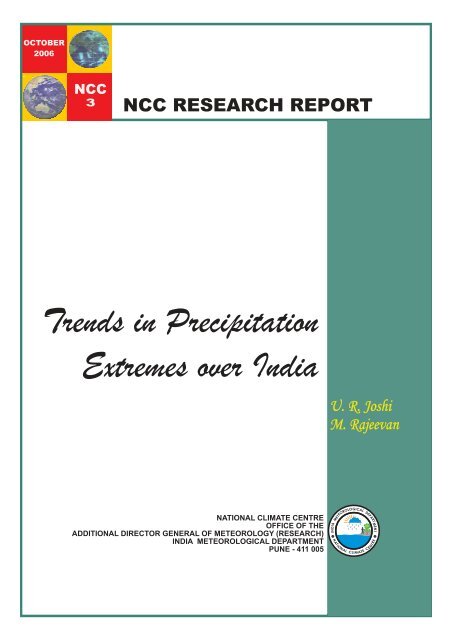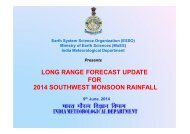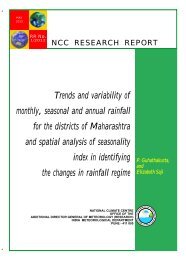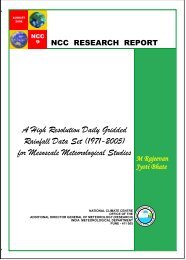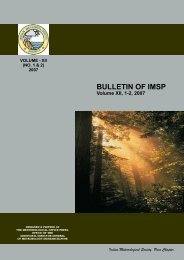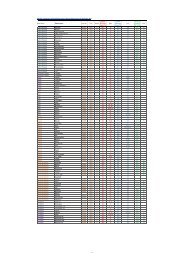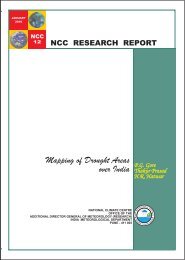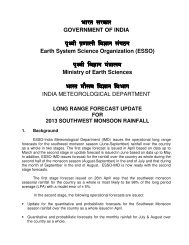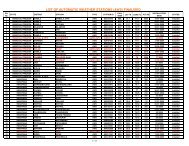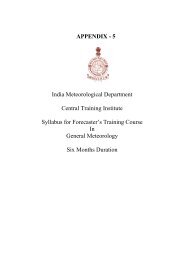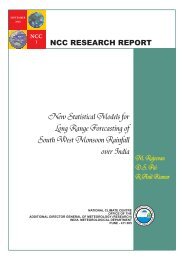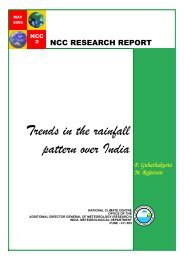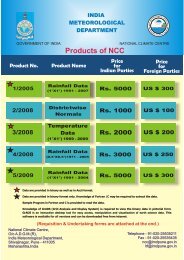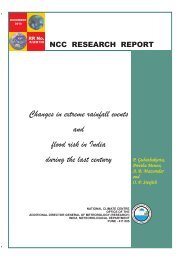Trends in Precipitation Extremes over India - (IMD), Pune
Trends in Precipitation Extremes over India - (IMD), Pune
Trends in Precipitation Extremes over India - (IMD), Pune
You also want an ePaper? Increase the reach of your titles
YUMPU automatically turns print PDFs into web optimized ePapers that Google loves.
OCTOBER2006NCC3NCC RESEARCH REPORT<strong>Trends</strong> <strong>in</strong> <strong>Precipitation</strong><strong>Extremes</strong> <strong>over</strong> <strong>India</strong>U. R. JoshiM. RajeevanNATIONAL CLIMATE CENTREOFFICE OF THEADDITIONAL DIRECTOR GENERAL OF METEOROLOGY (RESEARCH)INDIA METEOROLOGICAL DEPARTMENTPUNE - 411 005INDIAMETEOROLOGICALNAT IONALCLIMATEDEPARTMENTCENT RE
National Climate CentreResearch Report No: 3/2006<strong>Trends</strong> <strong>in</strong> <strong>Precipitation</strong> <strong>Extremes</strong> <strong>over</strong> <strong>India</strong>U. R. Joshi and M. RajeevanNational Climate Centre<strong>India</strong> Meteorological DepartmentPUNE. INDIA411005ncc@imdpune.gov.<strong>in</strong>
AbstractOne of the most significant consequences of global warm<strong>in</strong>g due to <strong>in</strong>crease <strong>in</strong>greenhouse gases would be an <strong>in</strong>crease <strong>in</strong> magnitude and frequency of extremeprecipitation events. In the present study the trends <strong>in</strong> extreme ra<strong>in</strong>fall <strong>in</strong>dices for theperiod 1901-2000 were exam<strong>in</strong>ed for 100 stations <strong>over</strong> <strong>India</strong>. The trends for thesouthwest monsoon season and annual period were calculated separately. Theresults show that most of the extreme ra<strong>in</strong>fall <strong>in</strong>dices have shown significant positivetrends <strong>over</strong> the west coast and northwestern parts of Pen<strong>in</strong>sula. However, two hillystations considered (Shimla and Mahabaleshwar) have shown decreas<strong>in</strong>g trend <strong>in</strong>some of the extreme ra<strong>in</strong>fall <strong>in</strong>dices.1
1. IntroductionAbout 60-90% of the annual ra<strong>in</strong>fall <strong>over</strong> <strong>India</strong> is received dur<strong>in</strong>g thesouthwest monsoon season (June to September), which is vital for the economy ofthe country. Inter-annual variation of seasonal and annual ra<strong>in</strong>fall is a subject formore serious research work <strong>in</strong> <strong>India</strong>. However, <strong>in</strong>formation about the long termtrends of ra<strong>in</strong>fall is also important. Previous studies have addressed the issue ofchanges <strong>in</strong> the mean ra<strong>in</strong>fall. For example, Guhathakurta and Rajeevan (2006) haveshown that there is no long term trend <strong>in</strong> the southwest monsoon seasonal ra<strong>in</strong>fall<strong>over</strong> the country as a whole, but there are significant regional variations. However,changes <strong>in</strong> extreme precipitation are also equally important to <strong>in</strong>vestigate. Impact ofclimate changes are felt most strongly through changes <strong>in</strong> climate extremes. Anypositive or <strong>in</strong>creas<strong>in</strong>g trend <strong>in</strong> the extreme ra<strong>in</strong>fall events is also a serious concern.The recent extreme heavy ra<strong>in</strong>fall event occurred <strong>over</strong> Mumbai on 26 th July 2005prompts us to th<strong>in</strong>k whether there is any significant trend <strong>in</strong> extreme ra<strong>in</strong>fall events<strong>over</strong> different parts of <strong>India</strong>.One of the most significant consequences of global warm<strong>in</strong>g due to <strong>in</strong>crease<strong>in</strong> greenhouse gases would be an <strong>in</strong>crease <strong>in</strong> magnitude and frequency of extremeprecipitation events. These <strong>in</strong>creased extreme precipitation events can be attributedto <strong>in</strong>crease <strong>in</strong> moisture levels, thunderstorm activities and large scale storm activity.In the global warm<strong>in</strong>g scenario, climate models generally predict an <strong>in</strong>crease <strong>in</strong> largeprecipitation events (Houghton et al 2001). The numerical modell<strong>in</strong>g community anddata analysts have shown <strong>in</strong>terest on the issue of extreme events occurr<strong>in</strong>g aroundthe world.The recent studies have shown that there is an <strong>in</strong>creas<strong>in</strong>g trend of extremeprecipitation events <strong>in</strong> USA and Australia (Easterl<strong>in</strong>g et al. 2000, Haylock andNicholls 2000, Groisman et al. 2001; Kunkel 2003), western New Zealand(Sal<strong>in</strong>gerand Griffiths 2001), the UK <strong>in</strong> w<strong>in</strong>ter (Osborn et al. 2000), and south Africa(Fauchereau et al. 2003). Extreme ra<strong>in</strong>fall events <strong>in</strong> Canada show no trend (Zhang2
et al. 2001; Kunkel 2003). Significantly decreas<strong>in</strong>g trends <strong>in</strong> extreme ra<strong>in</strong>fall eventshave been found <strong>in</strong> Western Australia (Haylock and Nicholls, 2000), south-east Asiaand parts of central Pacific (Griffiths et al. 2003), northern and eastern New Zealand(Sal<strong>in</strong>ger and Griffiths 2001), UK <strong>in</strong> summer (Osborn et al, 2000). Haylock et al.(2006) have recently addressed the trends <strong>in</strong> total and extreme ra<strong>in</strong>fall <strong>over</strong> SouthAmerica and their l<strong>in</strong>ks with sea surface temperatures.In <strong>India</strong> also, some studies have addressed this important issue. Rupa Kumaret al. (1992) exam<strong>in</strong>ed the trends <strong>in</strong> the total precipitation dur<strong>in</strong>g 1871-1984 andfound <strong>in</strong>creas<strong>in</strong>g trends <strong>in</strong> the precipitation amounts all along the west coast andnorthwest <strong>India</strong>. Their study also suggested a decreas<strong>in</strong>g trend <strong>in</strong> the <strong>over</strong>allprecipitation <strong>in</strong> the eastern Madhya Pradesh. The study of Chhabra et al. (1997)<strong>in</strong>dicates a decrease <strong>in</strong> the precipitation <strong>in</strong> hilly stations and an <strong>in</strong>crease <strong>in</strong> theprecipitation <strong>in</strong> the urbanized/<strong>in</strong>dustrialized cities. S<strong>in</strong>gh and Sontakke (2002)studied the fluctuations of precipitation amounts dur<strong>in</strong>g 1829-1999 for the Indo-Gangetic Region. Their study <strong>in</strong>dicates a significant trend from 1939 <strong>over</strong> the centralpart, and a significant decreas<strong>in</strong>g trend <strong>over</strong> eastern parts of the country. Soman etal (1988) analysed annual extreme ra<strong>in</strong>fall for the stations <strong>in</strong> Kerala state and foundthat stations <strong>in</strong> hilly terra<strong>in</strong> show a decreas<strong>in</strong>g trends. Guhathakurta and Rajeevan(2006) analysed ra<strong>in</strong>fall trends <strong>over</strong> 36 meteorological sub-divisions us<strong>in</strong>g a fixedra<strong>in</strong>-gauge network of <strong>over</strong> 1460 stations. Their study revealed significantdecreas<strong>in</strong>g trends <strong>in</strong> ra<strong>in</strong>fall <strong>over</strong> 3 meteorological sub-divisions (Jharkhand,Chattishgarh and Kerala) dur<strong>in</strong>g the southwest monsoon season (June toSeptember).However, there are only a couple of studies on address<strong>in</strong>g the changes <strong>in</strong>extreme precipitation events. S<strong>in</strong>ha Ray and Srivastava (2000) exam<strong>in</strong>ed the trend<strong>in</strong> the occurrence of heavy ra<strong>in</strong>fall events <strong>in</strong> <strong>India</strong>. They analysed ra<strong>in</strong>fall data of 151stations and considered a threshold of 7 cm and above. Sen Roy and Ball<strong>in</strong>g (2004)analysed the trends <strong>in</strong> the patterns of extreme precipitation events from 1910 to2000 and showed an <strong>in</strong>creas<strong>in</strong>g trend <strong>over</strong> most of western <strong>India</strong> <strong>in</strong>clud<strong>in</strong>g DeccanPlateau and a decreas<strong>in</strong>g to a neutral trend <strong>over</strong> the eastern half of the countryexcept the northeastern corner. Sen Roy and Ball<strong>in</strong>g (2006) analysed the spatialpatterns of trends <strong>in</strong> the frequency and <strong>in</strong>tensity of precipitation <strong>over</strong> <strong>India</strong> and3
concluded that most extreme events have become more frequent, particularly <strong>in</strong> thewestern half of the country. Francis and Gadgil (2006) us<strong>in</strong>g 37 years of ra<strong>in</strong>fall dataexam<strong>in</strong>ed <strong>in</strong>tense ra<strong>in</strong>fall events <strong>over</strong> the west coast of <strong>India</strong>. The probability ofoccurrence of <strong>in</strong>tense ra<strong>in</strong>fall events is high from mid June to mid August. They haveanalysed the synoptic features associated with these <strong>in</strong>tense ra<strong>in</strong>fall events. Kle<strong>in</strong>Tank (2006) exam<strong>in</strong>ed the changes <strong>in</strong> daily temperatures and precipitation extremes<strong>in</strong> central and south Asia. For this study, they have used daily data of 1961-2000.However, no robust signal of changes <strong>in</strong> precipitation extremes is observed <strong>over</strong> theregion. The only <strong>in</strong>dex with a significant (5% level) positive trend is the precipitationamount on very wet days. Also, the <strong>in</strong>crease <strong>in</strong> the contribution of very wet days tothe total amounts between 1961 and 2000 is significant at 5% level, imply<strong>in</strong>gdisproportionate changes of the precipitation extremes. Alexander et al (2005)exam<strong>in</strong>ed global observed changes <strong>in</strong> daily climate extremes of temperature andprecipitation us<strong>in</strong>g a suite of climate change <strong>in</strong>dices derived from daily data. Theyhave considered the data of 1951-2003 for the analysis. They have gridded theseasonal and annual climate change <strong>in</strong>dices for the analysis. Their results <strong>in</strong>dicate ageneral tendency towards wetter conditions throughout the 20 th century.There are many <strong>in</strong>dices for exam<strong>in</strong><strong>in</strong>g the extreme ra<strong>in</strong>fall events (Peterson etal. 2001). The earlier studies on extreme ra<strong>in</strong>fall <strong>over</strong> <strong>India</strong> exam<strong>in</strong>ed only a coupleof such <strong>in</strong>dices. The jo<strong>in</strong>t work<strong>in</strong>g group on climate change detection of WorldMeteorological Organisation (WMO-CCL) and the research program on ClimateVariability and Prediction CLIVAR (Peterson et al., 2001) recommended 15 <strong>in</strong>diceson extreme ra<strong>in</strong>fall. In this study, we have considered all these 15 <strong>in</strong>dices andexam<strong>in</strong>ed the long term changes associated with these <strong>in</strong>dices us<strong>in</strong>g 100 years ofdata. About half of the <strong>in</strong>dices considered are expressions of anomalies relative tothe local climatology <strong>in</strong> the standard-normal period 1961-90 enabl<strong>in</strong>g comparisonsbetween stations <strong>in</strong> different countries and regions. We have considered daily dataof longer period (1901-2000) for the present analysis. The present study also dealswith analysis for the extreme ra<strong>in</strong>fall dur<strong>in</strong>g the southwest monsoon season as wellas annual ra<strong>in</strong>fall <strong>over</strong> <strong>India</strong>. However, <strong>in</strong> this report, only the results of the analysisfor the southwest monsoon season (June to September) are discussed, which arefound similar with the annual ra<strong>in</strong>fall data also.4
In section 2, details of data used and the methodology adopted are discussed.In section 3, the results are discussed <strong>in</strong> detail and <strong>in</strong> section 4 conclusions aredrawn.2. Data and MethodologyFor calculat<strong>in</strong>g extreme ra<strong>in</strong>fall <strong>in</strong>dices, we have considered daily ra<strong>in</strong>fall datarecorded at ra<strong>in</strong>-gauge stations <strong>over</strong> <strong>India</strong>. <strong>India</strong> Meteorological Department (<strong>IMD</strong>),ma<strong>in</strong>ta<strong>in</strong>s ra<strong>in</strong>fall data observed at more than 6000 ra<strong>in</strong>gauge stations. However,only 199 observatories are ma<strong>in</strong>ta<strong>in</strong>ed by the <strong>IMD</strong> personnel. Rest of theobservatories is manned by other state g<strong>over</strong>nment agencies. For better quality, wehave considered only ra<strong>in</strong>fall recorded at 199 <strong>IMD</strong> observatory stations. Daily ra<strong>in</strong>falldata of <strong>IMD</strong> stations for the period 1901-2000 are considered for the present study.Data for a year is considered to be miss<strong>in</strong>g if the daily ra<strong>in</strong>fall data are not availablefor more than10% for the year. Fill<strong>in</strong>g of the miss<strong>in</strong>g daily data was not consideredas ra<strong>in</strong>fall is a highly variable parameter. Indices of extremes are sensitive tochanges <strong>in</strong> station location, exposure, equipments and observ<strong>in</strong>g practices. Thedaily ra<strong>in</strong>fall data archived at the National Data Centre (NDC) of <strong>IMD</strong> are qualitycontrolled and the outliers were identified. These outliers have been cross checkedwith the manuscripts and corrections were carried out whenever needed. Afterfilter<strong>in</strong>g the data, we could get only 100 stations for the period 1901-2000, <strong>in</strong> whichmore than 90% of time daily data are available. It may be mentioned that S<strong>in</strong>ha Rayand Srivastava (2000) considered stations with data more than 60% of time, whichmay not be suitable for studies on extreme ra<strong>in</strong>fall. Locations of these selectedstations are shown <strong>in</strong> Fig 1. S<strong>in</strong>ce we have put the condition of maximum 10%miss<strong>in</strong>g days for annual ra<strong>in</strong>fall values, few stations are available <strong>in</strong> the eastern partof central <strong>India</strong>. Maximum stations are available from pen<strong>in</strong>sular <strong>India</strong>.A list of <strong>over</strong> 50 <strong>in</strong>ternationally agreed climate change <strong>in</strong>dices for temperatureand ra<strong>in</strong>fall (WMO – CCl / CLIVAR) are available on web site (http://www.wmo.<strong>in</strong>t)with their explanation and equations for calculat<strong>in</strong>g them. For the present study, wehave considered a set of 10 ra<strong>in</strong>fall <strong>in</strong>dices (Table -1). Detailed procedures tocalculate these <strong>in</strong>dices are available at http://www.knmi.nl/samenw/eca.5
From the list prescribed by WMO, we have not considered <strong>in</strong>dices of R10mmand R20mm, because ra<strong>in</strong>fall events of 10 or 20 mm are quite common <strong>in</strong> the <strong>India</strong>nsub-cont<strong>in</strong>ent dur<strong>in</strong>g the southwest monsoon season. Hence, we have consideredR7.5cm (75 mm) and R12.5cm (125mm) to study the trends <strong>in</strong> heavy precipitationfrequencies of ra<strong>in</strong>fall greater than or equal to 7.5cm and 12.5cm.The def<strong>in</strong>itions of <strong>in</strong>dices allow seasonal and monthly partitions. As mentionedearlier, here, we have considered only the southwest monsoon season (June –September), the ma<strong>in</strong> ra<strong>in</strong>y season <strong>in</strong> <strong>India</strong>. Most of the <strong>in</strong>dices are def<strong>in</strong>ed <strong>in</strong> termsof counts of days cross<strong>in</strong>g the thresholds either absolute (fixed) thresholds orpercentile (variable) thresholds. Annual or seasonal day-count <strong>in</strong>dices based onpercentile thresholds are expressions of anomalies relative to the local climate.Consequently, the value of the thresholds is site specific. Such <strong>in</strong>dices allow forspatial comparisons, because they sample same part of precipitation (probabilitydensity) distributions at each station. On the other hand, annual/seasonal day-count<strong>in</strong>dices based on absolute thresholds are less suitable for spatial comparisons. Thereason be<strong>in</strong>g, <strong>over</strong> an area as large as <strong>India</strong>, thresholds of sample may vary differentfor different parts of the precipitation distributions. This means that <strong>in</strong> another climateregime the variability <strong>in</strong> such <strong>in</strong>dices readily stems from another season. Forexample, R7.5cm may be an extreme event <strong>in</strong> North-west <strong>India</strong>, while such eventsare quite common along the west coast and NE <strong>India</strong>.Extreme ra<strong>in</strong>fall <strong>in</strong>dices considered for the analysis are calculated for eachyear for each station. <strong>Trends</strong> of these <strong>in</strong>dices are calculated us<strong>in</strong>g l<strong>in</strong>ear regressionmodel to calculate the magnitude of the trends. S<strong>in</strong>ce most of the <strong>in</strong>dices are countsof days, a non-parametric model will be the best suited to test the significance ratherthan us<strong>in</strong>g Students’ t test. Hence, we have used the Kendall -Tau test (Press et al.,1986) to exam<strong>in</strong>e the significance of the trend. The trends referred to as significantexceed the 95% or 99% confidence limits <strong>in</strong> the Kendall–Tau test. As mentionedearlier, miss<strong>in</strong>g data was not filled up while calculat<strong>in</strong>g the <strong>in</strong>dices and trends.6
3. Results and DiscussionsWe have calculated the trends of 16 <strong>in</strong>dices for monsoon season and onannual scale and estimated the statistical significance us<strong>in</strong>g the Kendal-Tau test. Forthe present study, results and discussions are presented for the monsoon season <strong>in</strong>respect of the <strong>in</strong>dices listed <strong>in</strong> Table-1. However, the trends with the annual data arealso found similar. Table – 2 shows the percentage of stations show<strong>in</strong>g significanttrends <strong>in</strong> each <strong>in</strong>dex. The details of the trends <strong>in</strong> extreme <strong>in</strong>dices are given below.Significant trend values are plotted <strong>in</strong> Figs 2-6 and magnitude of the trends perdecade are listed <strong>in</strong> Table-3.R7.5cm – Number of days with ra<strong>in</strong>fall 7.5cm or moreFor the monsoon season, 63% of stations did not show any trend. 17% of thestations have shown positive significant trends. The significant positive trends areobserved (Fig. 2a) ma<strong>in</strong>ly along the west coast and some parts of central <strong>India</strong> and<strong>over</strong> Bihar. Higher values of trends are observed <strong>over</strong> stations of northern parts ofwest-coast. However, Mahabaleshwar has shown a significant negative trend <strong>in</strong>number of days with 7.5cm or more.R12.5cm – Number of days with ra<strong>in</strong>fall 12.5cm or moreWest coast stations and two stations of foothills of Himalayas have significantpositive trends (Fig. 2b) dur<strong>in</strong>g the monsoon season. Similar to R7.5cm,Mahabaleshwar has shown a significant negative trend <strong>in</strong> number of days with12.5cm or more.RX1day – Highest one day total and RX5day – highest 5 day totalOut of the 100 stations, 73% of the stations dur<strong>in</strong>g the monsoon season haveshown positive trend. However, the trends at only 15% of stations are statisticallysignificant. These stations (Fig. 2c) are ma<strong>in</strong>ly along the west coast of <strong>India</strong>, parts ofcentral <strong>India</strong>, northern parts of pen<strong>in</strong>sular <strong>India</strong> and few stations <strong>in</strong> West Bengal and7
Bihar. Over these regions, one day total ra<strong>in</strong>fall has shown an <strong>in</strong>creas<strong>in</strong>g trend.Similar results are also observed for the highest Five day precipitation (RX5day).The regions of significant positive trends (Fig. 2d) are ma<strong>in</strong>ly along the west coastand some parts of west central <strong>India</strong>. The magnitude of trends is also higher <strong>in</strong> theseareas.R75p – Moderate wet days – Days with ra<strong>in</strong>fall more than 75 percentile of the longperiod average.Seventeen percent of stations have shown significant positive trends. Thesestations are distributed (Fig. 3a) along the west coast of <strong>India</strong>, northern parts of <strong>India</strong>and west central <strong>India</strong> (west Madhya Pradesh). Only 5% of stations have shownsignificant negative trends.R75pTOT – <strong>Precipitation</strong> fraction due to moderate wet daysThe <strong>in</strong>dex R75pTOT determ<strong>in</strong>es the contribution of moderate wet days(ra<strong>in</strong>fall with more than 75 percentile) on the seasonal ra<strong>in</strong>fall total. Dur<strong>in</strong>g themonsoon season, 19% of stations showed significant positive trend. These stations(Fig. 3b) are ma<strong>in</strong>ly <strong>over</strong> along the west coast, southwest parts of central <strong>India</strong>,northern pen<strong>in</strong>sular <strong>India</strong>, and few stations <strong>in</strong> Orissa. Over these regions, thecontribution from the ra<strong>in</strong>fall amount higher than 75 percentile has <strong>in</strong>creased. Only3% stations have shown significant negative trend.In a similar fashion, two more <strong>in</strong>dices for 95 percentile and 99 percentile arealso calculated. Similar to R75p, the R95p <strong>in</strong>dex also shows significant positivetrends for 16% of stations. Significant positive trends are also noticed for 15% of thestations dur<strong>in</strong>g the monsoon season for the <strong>in</strong>dex R95pTOT. These significanttrends (Fig. 3c & 3d) are along the west coast and northwestern parts of Pen<strong>in</strong>sular<strong>India</strong>, which <strong>in</strong>cludes Maharashtra and parts of northern Karnataka. The <strong>in</strong>dices ofR99p and R99pTOT showed (Fig. 4a and 4b) significant positive trends along thefoothills of Himalayas and south pen<strong>in</strong>sular <strong>India</strong>.8
Regional Average <strong>Trends</strong>In the time series of station data, changes <strong>in</strong> rout<strong>in</strong>e observ<strong>in</strong>g practices mayhave <strong>in</strong>troduced <strong>in</strong>homogeneities of non-climatic orig<strong>in</strong> that severely affect theextremes (Kle<strong>in</strong> Tank et al. 2006). The results for <strong>in</strong>dividual stations may be affectedby <strong>in</strong>homogeneities <strong>in</strong> the underly<strong>in</strong>g series that were not detected. Therefore, robustconclusions can be drawn from tendencies <strong>over</strong> large areas and regional averagetrends. More<strong>over</strong>, changes <strong>in</strong> extreme precipitation due to global warm<strong>in</strong>g may bebetter revealed <strong>in</strong> regional average trends and not at the station level. This is due tothe fact that due to global warm<strong>in</strong>g, enhancement of moisture level may take placeon a larger scale and the associated enhancement <strong>in</strong> convection may take place<strong>over</strong> a larger area. Therefore, we have repeated the analysis by divid<strong>in</strong>g the country<strong>in</strong>to 17 areas as shown <strong>in</strong> Fig. 5. Number of stations used for area averag<strong>in</strong>g is also<strong>in</strong>dicated <strong>in</strong> the regional boxes. The region-1 is the west coast with 10 stations.The results are shown <strong>in</strong> Table – 4. The changes observed at the stationsalong the west coast are realized even if we average the data <strong>over</strong> the west coast.The results from <strong>in</strong>dividual stations and area average data are consistent. Similarly,<strong>over</strong> the region-11 (northern parts of <strong>India</strong>), the signals are consistent. However,stations <strong>over</strong> the region-2 (south pen<strong>in</strong>sula) have not shown much significantchanges <strong>in</strong> the climate <strong>in</strong>dices. But <strong>in</strong> the area averaged analysis, many <strong>in</strong>dices(RX1DAY, R75p, R75pTOT and R95p) have shown significant <strong>in</strong>creas<strong>in</strong>g trends.Similarly, <strong>in</strong>dividual stations <strong>over</strong> NE <strong>India</strong> (Region-14) have not shown anysignificant changes <strong>in</strong> the climate <strong>in</strong>dices. However, when we made area average<strong>over</strong> the region, many <strong>in</strong>dices have shown significant trends.Fig.6. shows the time series of RX1DAY, RX5DAY, R95p and R95pTOTaveraged <strong>over</strong> the west coast (region). All the time series are show<strong>in</strong>g an <strong>in</strong>creas<strong>in</strong>gtrend, especially the R95pTOT. Dur<strong>in</strong>g the recent years (after 1990), the per cent ofseasonal ra<strong>in</strong>fall from very wet days (R95pTOT) is consistently more than 25%.9
6. ConclusionsFrom the present study, the follow<strong>in</strong>g ma<strong>in</strong> conclusions can be drawn.1. Most of the extreme ra<strong>in</strong>fall <strong>in</strong>dices have shown significant positive trends<strong>over</strong> the west coast stations and northwestern parts of Pen<strong>in</strong>sula(Maharashtra). Along the west coast, contribution from the heaviest (95and 99 percentile) events to the total seasonal ra<strong>in</strong>fall has <strong>in</strong>creasedsignificantly. This result is important <strong>in</strong> view of the recent deluge occurred<strong>over</strong> Mumbai.2. Positive trends were also observed <strong>over</strong> the region 20 0 to 30 0 N and 75 0 to80 0 E.3. Individual stations <strong>over</strong> North east <strong>India</strong> did not show any significanttrends. However, averaged <strong>over</strong> the area, some climate <strong>in</strong>dices(R75pTOT, R95p, R95pTOT) showed <strong>in</strong>creas<strong>in</strong>g trends.4. It is <strong>in</strong>terest<strong>in</strong>g to note that two hilly stations considered <strong>in</strong> this study(Simla and Mahabaleshwar) have shown significant decreas<strong>in</strong>g trends ofsome extreme ra<strong>in</strong>fall <strong>in</strong>dices.Changes <strong>in</strong> the climate <strong>in</strong>dices revealed <strong>in</strong> this study may be associated withvariability <strong>in</strong> the large-scale atmospheric circulation patterns. However, to whatextent the trends observed <strong>in</strong> this study are related with atmospheric circulationchanges needs to be addressed <strong>in</strong> future studies.The area of concern is northern parts of west coast and adjo<strong>in</strong><strong>in</strong>gMaharashtra. This study suggested that extreme ra<strong>in</strong>fall events <strong>over</strong> this region hasshown a significant <strong>in</strong>creas<strong>in</strong>g trend. The study of Guhathakurta and Rajeevan(2006) has brought out the result that this region has also witnessed significant<strong>in</strong>crease <strong>in</strong> monsoon seasonal and annual ra<strong>in</strong>fall. This <strong>in</strong>ference was also madeus<strong>in</strong>g about 100 years of ra<strong>in</strong>fall data. Us<strong>in</strong>g a high resolution regional climatemodel, Rupa Kumar et al. (2006) have shown <strong>in</strong> the global warm<strong>in</strong>g scenario,summer monsoon precipitation <strong>over</strong> most parts of Maharashtra and adjo<strong>in</strong><strong>in</strong>g southGujarat region is expected to <strong>in</strong>crease on an average by 5 mm/day. This will10
translate <strong>in</strong>to a huge <strong>in</strong>crease <strong>in</strong> seasonal ra<strong>in</strong>fall <strong>over</strong> this region. If we assume theobserved trend <strong>in</strong> <strong>in</strong>crease of <strong>in</strong>tense ra<strong>in</strong>fall events will also persist <strong>in</strong>to future, assuggested by the climate models, probability of <strong>in</strong>tense ra<strong>in</strong>fall events (like the oneexperienced at Mumbai <strong>in</strong> 2005) <strong>in</strong> near future will also <strong>in</strong>crease proportionally.AcknowledgementsWe are thankful to Dr (Mrs) N.Jayanthi, LACD ADGM (Research) and Shri.Thakur Prasad, DDGM (Climatology) for provid<strong>in</strong>g facilities to do this work and forencouragement. We also thank Shri.G.S.Prakasa Rao, Director for his support forthis work. The first author participated <strong>in</strong> the WMO CLIVAR International Workshopon Enhanc<strong>in</strong>g South-central Asian Climate Change Monitor<strong>in</strong>g and Indices held at<strong>Pune</strong> <strong>in</strong> Feb 2005 and benefitted from the workshop.11
ReferencesAlexander, L. et al., 2005. Global observed changes <strong>in</strong> daily climate extremes oftemperature and precipitation. J. Geophys.Res., 32: D05109, doi10.1029/2005/JD006290.Chhabra, B. M., Prakasa Rao, G. S. and Joshi U. R., 1997. A comparative study ofdifferences <strong>in</strong> the averages of temperatures and ra<strong>in</strong>fall <strong>over</strong> the <strong>India</strong>nstations dur<strong>in</strong>g the periods 1931 – 60 and 1961-90. Mausam 48: 1, 65-70.Easterl<strong>in</strong>g D R, Evans J L Groisman P Y, Karl T R, Kumbel K E, Ambenje P. 2000.Observed variability and trends <strong>in</strong> extreme climate events: a brief review.Bullet<strong>in</strong> of the American Meteorological Society 81: 417 – 425.Faucherean N. Trzasku S. Roualt M, Richard Y. 2003. Ra<strong>in</strong>fall variability andchanges <strong>in</strong> the southern Africa dur<strong>in</strong>g twentieth century <strong>in</strong> the global warm<strong>in</strong>gcontext. Natural Hazards 29: 139 – 154.Francis, P.A. and Gadgil, S., 2006. Intense ra<strong>in</strong>fall events <strong>over</strong> the west coast of<strong>India</strong>. Meteorol Atmos. Phys., doi 10.1007/s00703-005-0167-2.Griffiths G M, Sal<strong>in</strong>ger M J, Leleu I. 2003. <strong>Trends</strong> <strong>in</strong> extreme daily ra<strong>in</strong>fall across thesouth Pacific and relationship to the South Pacific convergence zone.International Journal of Climatology 23: 847 – 869.Groisman P Y, Knight R W, Karl T R. 2001. Heavy precipitation and high stream flow<strong>in</strong> the contiguous United States : <strong>Trends</strong> <strong>in</strong> the twentieth century. Bullet<strong>in</strong> ofthe American Meteorological Society 82: 219 – 246.Guhathakurta. P., and Rajeevan. M., 2006, <strong>Trends</strong> <strong>in</strong> the ra<strong>in</strong>fall pattern <strong>over</strong> <strong>India</strong>,NCC Research Report No 2/2006, May 2006, <strong>India</strong> MeteorologicalDepartment, pp 23.Haylock M. R., Nicholls N, 2000. <strong>Trends</strong> <strong>in</strong> extreme ra<strong>in</strong>fall <strong>in</strong>dices for an updatedhigh quality data set for Australia 1910 – 1998. International Journal ofClimatology 20: 1533 – 1541.Haylock M. R. et al., 2006. <strong>Trends</strong> <strong>in</strong> total and extreme south American ra<strong>in</strong>fall <strong>in</strong>1960-2000 and l<strong>in</strong>ks with sea surface temperature. Journal of Climate19:1490-1512.12
Houghton Jr, D<strong>in</strong>g Y, Griggs Dj, Noguer M, Van der L<strong>in</strong>den PJ, Dai X, Maskell K,Johson CA (eds)., 2001. Climate Change 2001 ‘The Scientific Basis’,Cambridge University Press, Cambridge, UK.Kle<strong>in</strong> Tank et al., 2006. Changes <strong>in</strong> daily temperature and precipitation extremes <strong>in</strong>Central and South Asia. J.Geophys.Res., 111: No D16, D16105, doi10.1029/2005JD006316.Kunkel K E . 2003. North American trends <strong>in</strong> extreme precipitation. Natural Hazards29: 291 – 305.Osborn T J, Hulme M, Jones P D, Basnett T A. 2000. Observed trends <strong>in</strong> the daily<strong>in</strong>tensity of United K<strong>in</strong>gdom precipitation. International Journal of Climatology20: 347 – 364.Peterson T. C, Folland C. Gruza G, Hogg W, Mokssit A and Plummer, 2001. Reporton the activities of the work<strong>in</strong>g group on climate change detection and relatedrapporteurs 1998 – 2001. WMO Rep. WCDMP 47, WMO – TD 1071, Geneva,Switzerland 143 pp.Press W. H., Flannery B. P., Teukalsky, S. A., and Vetterl<strong>in</strong>g, W. T. 1986. NumericalRecipes: The art of scientific comput<strong>in</strong>g; Cambridge Univ., Press Cambridgepp 488 – 493.Rupa Kumar, K., Pant, G. B., Parthasarathy, B. and Sontakke, N., 1992. Spatial andsub-seasonal patterns of the long-term trends of <strong>India</strong>n summer monsoonra<strong>in</strong>fall. Int. Jou. Clim.12: 257-268.Rupa Kumar, K., and co-authors, 2006, High resolution climate change scenarios for<strong>India</strong> for the 21 st century. Current Science. 90: 3, 334-345.Sal<strong>in</strong>ger M J, and Griffiths G M 2001. <strong>Trends</strong> <strong>in</strong> New Zealand daily temperature andra<strong>in</strong>fall extremes. International Journal of Climatology 2; 1437 – 1452.Shouraseni Sen Roy and Ball<strong>in</strong>g Jr R C. 2004; <strong>Trends</strong> <strong>in</strong> extreme daily precipitationon <strong>in</strong>dices <strong>in</strong> <strong>India</strong>., Int. J. Climatol., 24: 457 – 466.Shouraseni Sen Roy and Ball<strong>in</strong>g Jr R C. 2006; Analysis of spatial patterns of trends<strong>in</strong> the frequency and <strong>in</strong>tensity of <strong>India</strong>n precipitation. Mausam, 57: 3,431-436.S<strong>in</strong>gh, N. and Sontakke, N. A., 2002, On climate fluctuations and environmentalchanges of the Indo Gangetic pla<strong>in</strong>s <strong>in</strong> <strong>India</strong>, Climate Change, 52: 287-313.S<strong>in</strong>ha Ray, K.C. and Srivastava, A. K. 2000, Is there any change <strong>in</strong> extreme eventslike heavy ra<strong>in</strong>fall? Current Science, 79: 2, 155 – 158.13
Soman M K, Krishnakumar K, S<strong>in</strong>gh N. 1988. Decreas<strong>in</strong>g trend <strong>in</strong> the ra<strong>in</strong>fall ofKerala. Current Science 57: 5 – 12.Zang X, Hogg W D, Mekis F. 2001. Spatial and temporal characteristics of heavyprecipitation events <strong>over</strong> Canada. Journal of Climatology 14: 1923 – 1936.14
Table – 1Extreme Ra<strong>in</strong>fall Indices considered for the studyS. N. Description Code1. Heavy <strong>Precipitation</strong> days (<strong>Precipitation</strong> ≥ 7.5 cm) R7.5cm2. Very Heavy <strong>Precipitation</strong> Days (<strong>Precipitation</strong> ≥ 12.5 cm) R12.5cm3. Highest 1 day precipitation amount RX1day4. Highest 5 day precipitation amount RX5day5.Moderate wet days(days with RR > 75 th percentile of daily precipitation R75pamount)6. <strong>Precipitation</strong> fraction due to Moderate wet Days R75pTOT7. Very wet days (days with RR > 95 th percentile) R95p8. <strong>Precipitation</strong> fraction due to Very wet days R95pTOT9. Extremely wet days (days with RR > 99 th percentile) R99p10. <strong>Precipitation</strong> fraction due to extremely wet days R99pTOTTable -2Per cent of stations show<strong>in</strong>g significant trendsR7.5cmR12.5cmRX1DAYIndex % No.of StationsHav<strong>in</strong>g +ve trend 32 11 73 78 57 70 42 75 13 70-ve trend 5 2 26 22 22 22 6 21 3 28+ve Sig. trend 17 8 15 9 17 19 16 17 10 15-ve Sig. trend 2 1 1 3 5 3 1 1 3 1RX5DAYR75PR75PTOTR95PR95PTOTR99PR99PTOT15
Table - 3Significant trend values (per decade) for the ra<strong>in</strong>fall <strong>in</strong>dicesStationLongLatR7.5cmR12.5cmRX1dayRX5dayR75pR75pTOTR95pR95pTOTR99pR99pTOTAGRA 78.03 27.17 0.40AHMEDABAD AERO 72.63 23.07 1.40AJMER 74.62 26.45 6.60 0.10 1.30ALIPUR 88.33 22.53 0.50AMBALA 76.77 30.38 0.10 0.10 3.30 5.90 0.40 1.20 0.10 0.10 0.80AMRAOTI 77.78 20.93 0.10 1.00ANGUL 85.10 20.83 0.10 0.90 0.20 1.30BAHRAICH 81.60 27.57 0.10 8.70 0.10 0.80BALASORE 86.93 21.50 0.10 4.70 0.80 0.10 0.90BANGALORE C.O. 77.58 12.97 0.20 0.10BEGUMPET/HYD.AER 78.47 17.45 2.80 0.70BELGAUM 74.53 15.85 0.60BIJAPUR 75.72 16.82 1.80 0.20BOMBAY COLABA 72.82 18.90 0.30 0.10 8.00 12.10 0.60 1.00 0.20 0.10 0.60DARBHANGA 85.90 26.17 -8.00 -0.70 -1.40 -0.10GAYA AERODROME 84.95 24.75 -0.10 -3.60 -5.20 -1.20 -0.10 -1.30HOSHANGABAD 77.77 22.77 0.30INDORE 75.80 22.72 0.10 3.80 10.50 0.30 0.90 0.20 1.60JAGDALPUR 82.03 19.08 -0.50JALPAIGURI 88.72 26.53 9.10 0.50 1.00 0.10 1.10KAKINADA 82.23 16.95 0.10KHANDWA 76.37 21.83 0.10 5.50 0.30 0.80 0.10 1.40KOCHI FORT 76.23 9.97 0.50 1.00KURNOOL 78.07 15.83 2.60 0.30 1.60 0.20 1.60LUDHIANA 75.87 30.93 0.20MAHABALESHWAR 73.67 17.93 -0.70 -0.40 -0.70 -0.70 -0.20MAINPURI 79.05 27.23 0.10 0.40 1.00 0.10MANGALORE 74.85 12.87 0.30 0.10 4.60 0.80 0.20 0.80 0.10 0.60NELLORE 79.98 14.45 0.40NEW DELHI/SAFDAR 77.20 28.58 0.40NUNGAMBAKKAM 80.25 13.07 0.50PANJIM 73.82 15.48 0.30 0.20 7.60 13.80 0.80 0.30 1.20 0.10 0.70PARBHANI 76.77 19.27 0.10 0.90PHALODI 72.37 27.13 -0.20PORT BLAIR 92.72 11.67 0.10 0.40PURI 85.82 19.80 0.10 0.80 0.10 1.20PURNEA 87.47 25.77 0.20 0.10 5.40 1.10 0.10 0.80RAICHUR 77.35 16.20 0.10 1.10 0.80RATNAGIRI 73.33 16.98 0.50 0.20 6.30 11.00 0.80 1.10 0.40 1.50 0.10 0.60SIMLA 77.17 31.10 -5.70 -0.60 -0.60 -0.10SRINAGAR 74.83 34.08 1.10SURAT 72.83 21.20 0.20 3.50 10.20 0.90TEZPUR 92.78 26.62 0.40 0.10 0.90TIRUCHI.PALLI(A) 78.72 10.77 1.40VERAVAL 70.37 20.90 0.2 0.10 6.90 17.00 0.50 1.70 0.20 2.20VISAKHAPATNAM AP 83.23 17.72 0.3016
Table - 4Ra<strong>in</strong>fall Indices (1901-2000) – Significant <strong>Trends</strong>IndexR7.5cmR12.5cmRX1DAYRX5DAYR75pR75pTOTR95pR95pTOTR99pR99pTOTRegion1 + ve N + ve + ve N + ve + ve + ve + ve + ve2 N N + ve N + ve + ve + ve N N N3 N N N N N N N N N N4 N N N + ve N N N N N N5 N N N N N N N N N + ve6 N N N N N N N + ve N N7 N N N + ve N N + ve N + ve N8 N N N N N N N N N N9 N N N N N N N N N N10 N N N N N N N N N N11 N N N N N + ve + ve + ve N N12 N + ve N + ve N N N N + ve + ve13 N N N N N N N + ve N N14 N N N N N + ve + ve + ve N N15 N N N ─ ve ─ ve N N N N N16 N N N N N N N N N N17 + ve N N N N + ve N N N NN : No Significant Trend + ve : Positive Significant Trend─ ve : Negative Significant Trend17
Fig. 1 : Stations considered for the study18
abcd- Significant Positive <strong>Trends</strong> - Significant Negative <strong>Trends</strong>Fig. 2 : Significant trends of ra<strong>in</strong>fall <strong>in</strong>dices (a) R7.5cm (b) R12.5cm (c) RX1day and(d) RX5day for Southwest Monsoon Season (June to September).19
abcd- Significant Positive <strong>Trends</strong> - Significant Negative <strong>Trends</strong>Fig. 3 : Significant trends of ra<strong>in</strong>fall <strong>in</strong>dices (a) R75p (b) R75pTOT(c) R95p and(d) R95pTOT for the Southwest Monsoon Season (June to September).20
ab- Significant Positive <strong>Trends</strong> - Significant Negative <strong>Trends</strong>Fig. 4 : Significant trends of ra<strong>in</strong>fall <strong>in</strong>dices (a) R99p (b) R99pTOT for thesouthwest Monsoon season (June to September).21
Figures <strong>in</strong> the parenthesis <strong>in</strong>dicate the number of stations averaged <strong>in</strong> the regionRegion 1 : West coast with 10 stations. Region 2 & 3 are without the west coast stations.Fig. 5 : Regions considered for the study22
Ra<strong>in</strong>fall <strong>in</strong> mm200150100500Ra<strong>in</strong>fall Index RX1day for Region 1Trend = 2.43 mm / decade1901191119211931194119511961197119811991YearRa<strong>in</strong>fall <strong>in</strong> mm450400350300250200150100500Ra<strong>in</strong>fall Index RX5day for Region 1Trend = 5.98 mm / decade190119111921193119411951Year1961197119811991Fig 6: Time series of the Extreme Ra<strong>in</strong>fall Indices for the region 123
Percentage50403020100Ra<strong>in</strong>fall Index R95pTOT for Region 1<strong>Trends</strong> = 1 percent / decade190119111921193119411951Year1961197119811991Ra<strong>in</strong>fall Index R95p for Region 120Trend = 0.3 days / decade15Days1050190119111921193119411951Year1961197119811991Fig 6 (contd) : Time series of the Extreme Ra<strong>in</strong>fall Indices for the region 124
N C C RESEARCH REPORTS New statistical models for long range forecast<strong>in</strong>g of southwest monsoon ra<strong>in</strong>fall <strong>over</strong> <strong>India</strong>,M. Rajeevan, D. S. Pai and Anil Kumar Rohilla, Sept. 2005. <strong>Trends</strong> <strong>in</strong> the ra<strong>in</strong>fall pattern <strong>over</strong> <strong>India</strong>, P. Guhathakurta and M. Rajeevan, May 200625


